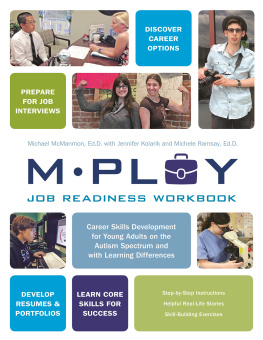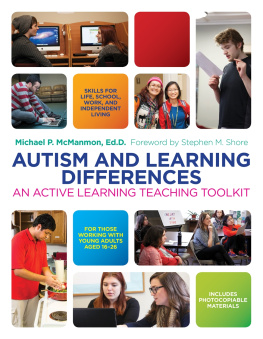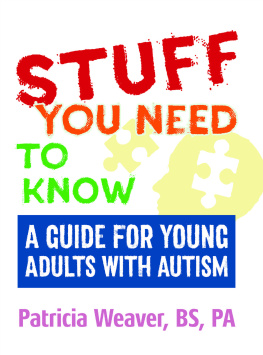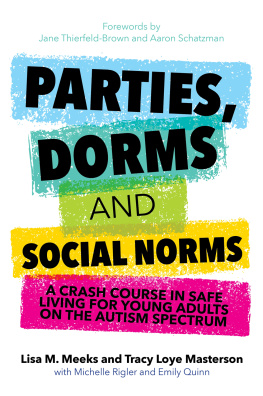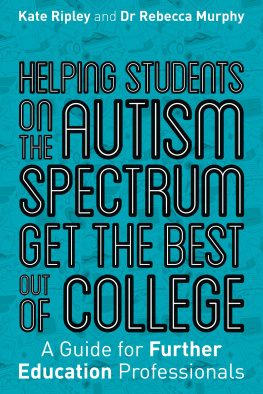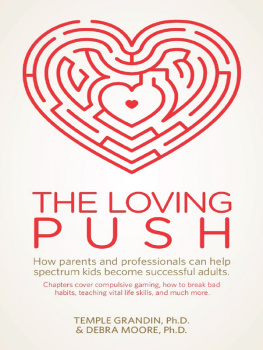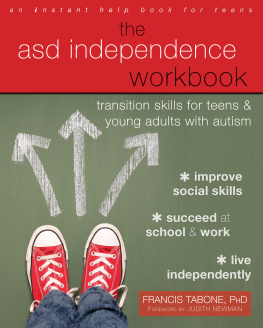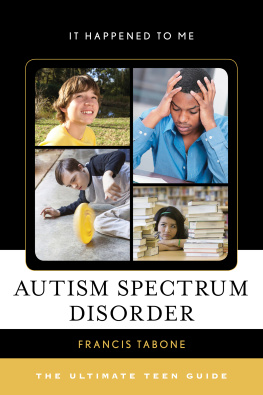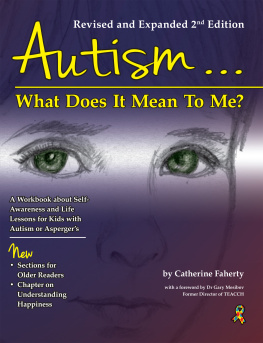
MPLOYA JOB
READINESS WORKBOOK
CAREER SKILLS DEVELOPMENT FOR YOUNG ADULTS ON THE AUTISM SPECTRUM AND WITH LEARNING DIFFICULTIES
Michael P. McManmon with
Jenifer Kolarik and Michele Ramsay
Foreword by Carol Gray

Jessica Kingsley Publishers
London and Philadelphia
Contents
Foreword
I have had the opportunity to write several forewords. Never, though, has my work on behalf of people with autism so directly prepared me for providing testimony to the value and critical importance of a new book as it does with this one. If theres any advantage to being older, it is how our perspective broadens with each year. It makes us better consumers in the search for best practice in our field; the goals that are important and the methods that will best help us get there. Instead of wondering if a program or strategy will work, we recognize those that will. As a result of my experiences as a professionaland as someone who has known the lead author of this book, Dr. Michael McManmon, for many yearsI believe that MPLOY: A Job Readiness Workbook is destined to be the unequalled go to resource for young people with autism and other learning difficulties, and those working on their behalf, as they navigate the bridge from education to employment.
I began my career as a teacher with four students with autism. On my desk was a framed note to myself: These are not my children, and I cannot be with them in the future. Little did I know that I would be with them longer than I expected. I worked on their behalf for fifteen consecutive years. Of course, many other students joined my caseload along the way. The note on my desk was always there; a continual reminder to teach for the day when I would not be with them.
Several years into my teaching career, my position changed. I became a consultant, supporting those who worked directly with my students: parents, professionals, and (a new group of people to our program) owners and employees of businesses in our community. A federal grant made it possible for us to establish on-site vocational and career experiences for our students. It quickly became apparent where our past educational efforts were relevant, and also where we had wasted valuable time. There were concepts and skills that we had missed and needed to teach now. We revamped our curriculum to reflect what we were learning from the community and the world of work.
Most of our students graduated from our program into employment. On occasion to this day, I encounter them, usually where they have worked for yearsand sometimes in their new place of work. My first year of teaching, I did have a sense that the future was closer than it seemed. What I didnt realize, though, was how very long the future is and how much we can accomplish there. I have watched yesterdays decisions play out today. One open door often leads to another for decades to come.
In the early 1990s, my students, our educational team, and the staff of our vocational training sites in the community had to navigate the trail between school and work without a compass. In sharp contrast, this workbook is on task, steadfastly focused, with no wasted time and a sense of what is needed to be ready for what lies ahead. It is an insightfully and intelligently paved road created by people who are amply qualified for the task.
I have known Dr. Michael McManmon, the lead author, for many years. I cannot remember exactly where we met. It is likely that our paths first crossed at a conference or workshop. Over the years, I have come to know Michael as a respected professional and a valued friend to reconnect with on the road. Michael was 53 years of age when he received the diagnosis with Aspergers Syndrome. His first-hand perspective growing up with autism, coupled with his education and professional experience, has led to an impressive list of contributions to our field. Wherever and whenever I have the opportunity to connect with Michael on the road, it is always a comfortable conversation with room to review, rethink, rechargebefore we both move on to what life holds next. Thats the Michael that isnt mentioned in his Authors Note, but is evident throughout this volume. Michael has a rare talent. He casually and patiently helps others identify their path for whats ahead. Dr. Michael McManmon and his co-authors are more than qualified to guide you on the bridge from today to the future.
Regardless of what has brought you to consider this workbook, Ive several years of trial, error, and experience to suggest that you have made a very smart choice. As I read the discussions in this workbook, reviewed the many case examples, and considered the practice activities, I was so impressed by the thought, insight, organization, and expertise behind them. I nodded as I recognized this workbooks value and its potential for success.
If you are a parent or professional working with young adults as they make the transition from school to work, this book will support you with a wealth of background information and hands-on ideas for practice. The same goes if you are a young adult making this transition on your own (or better yet with someone like a job coach or parent working with you). By selecting this workbook, youve completed the first step to a fulfilling futurevery successfully. I join Michael and his co-authors with best wishes for the future. It begins on the following pages.
Carol Gray
Authors Note
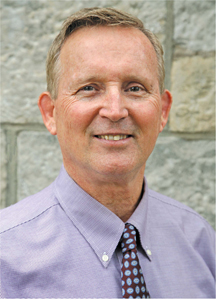
You might not want to know this, but your real handicap may be the way you think about yourself. Otherwise, how do you explain individuals born without legs competing in the Olympics, or deaf individuals writing musical scores, or me founding five programs around the U.S. for young adults with Learning Differences and Autism Spectrum Disorder (ASD) after being diagnosed at the age of 53 with Aspergers?
Our own attitudes hold us back. Half the battle is simply learning to become self-change agents. The other half is following advice and being willing to change. It seems simplistic and it is. The problem is our own cognitive rigidity: we want to do the same things over and over, even though deep down we know that we arent going to go anywhere without doing something different.
This workbook was designed specifically for young adults with Learning Differences and ASD. It will help you to make those attitude adjustments, find a career that matches your interests and abilities, and develop your practical skills. It is informed by my experience over the last 45 years working with students with Learning Differences. For most of that time I have operated my own group homes and programs, including the College Internship Program (CIP), a comprehensive training program that assists young adults on the Autism Spectrum and with Learning Differences to pursue employment, college degrees, and independent living. All of our students have gone on to find employmentin government agencies, hospitals, historical societies, gardens, markets, libraries, childrens centers, the Coast Guard, technological institutions, and moreand they have attended colleges from the University of California to the Florida Institute of Technology.
While working with students on the Autism Spectrum, I earned a Masters in Counseling, a Masters in Human Development, and a Doctorate in Special Education and became a Licensed Psychologistbut I didnt start there. I was born into a family with seven brothers and sisters with many Learning Differences. My mom got me my first summer job in high school working at the church doing landscaping and painting. I was a shy, non-assertive boy who was very responsible but had no experience in the world of work. My struggles were the same as many of our students. I did not know what I wanted to do for work, but I had some special interests in gardening and art, and so my mom picked those areas to find jobs for me.
Next page
